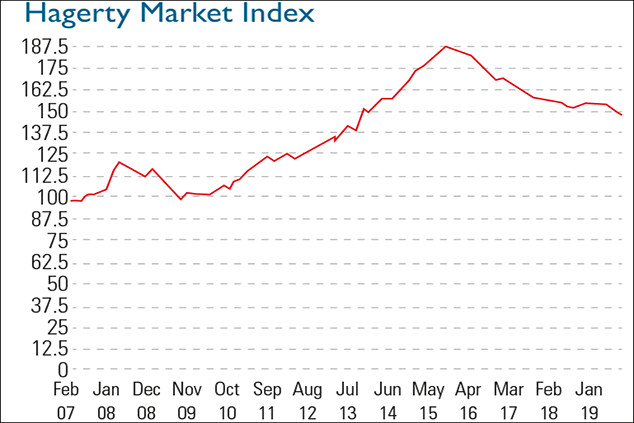Collectable classic cars, reimagined
Classic cars have been a spectacular investment for the last few decades, but with prices now sky-high, there are signs of a slowdown in the market. Yet help could come from a decidedly modern quarter...


Classic cars have been a spectacular investment for the last few decades, but with prices now sky-high, there are signs of a slowdown in the market. Yet help could come from a decidedly modern quarter.
For almost four decades, the classic car market has been motoring higher. From 1980 to 2017, classic cars were by far the best-performing collectable asset, according to the Credit Suisse "Global Investment Returns Yearbook 2018" (that's when the highly respected annual report last looked at alternative investments). In that time the value of the classic car market, as measured by the benchmark Historic Automobile Group International (HAGI) Top index, grew by 242 times.
For much of 2018, the trend continued. In August of that year, the hammer came down on the most expensive car ever sold at auction. A beautiful 1962 Ferrari 250 GTO sold for a staggering $48.4m with RM Sotheby's at the Pebble Beach Concours d'Elegance in California, the finale of Monterey Car Week. Ferrari only made 36 of them, and in their heyday they dominated the racing world, winning 300 races between them. Another 250 GTO reportedly sold for even more earlier that year in a private sale: $70m. At Pebble Beach, "a kind of Coachella for classic cars", as CNBC put it, $368m was raked in at auction in that week; a 12% increase even on 2017.
MoneyWeek
Subscribe to MoneyWeek today and get your first six magazine issues absolutely FREE

Sign up to Money Morning
Don't miss the latest investment and personal finances news, market analysis, plus money-saving tips with our free twice-daily newsletter
Don't miss the latest investment and personal finances news, market analysis, plus money-saving tips with our free twice-daily newsletter
Has the car market hit the skids?
And then the wheels came off the market. At this year's Monterey Car Week, "demand for cars costing more than $1m collapsed", says Kristie Pladson on Bloomberg. According to classic-car insurers and analysts Hagerty, the sell-through rate (a measure of how much stock is successfully sold) fell to 48% from 67% a year earlier. The sales of cheaper models held up rather better, showing the market hadn't altogether puttered to a standstill.
Yet "the trend highlights the unsustainable pace of growth for prices of vintage cars in recent years", says Pladson. "A glut of inventory has taken a toll and some investor-collectors new to the game are proving more skittish than traditional enthusiasts in the face of economic uncertainty."
In fact,the reality is that the broader classic-car market has been enduring a gradual downturn ever since hitting a peak in September 2015, as the chart below left (the Hagerty Market Index, based on volumes and values of collector cars traded, adjusted for inflation) indicates. There is, however, another trend developing in classic cars that may help to keep the overall market afloat a while longer.

(Source: Hagerty)
The next big thing: collectable electric cars
In May 2018, the newly wed Duke and Duchess of Sussex sped away in a classic 1968 E-Type Jaguar the picture of old English style. But a glance under the bonnet revealed not a 4.2-litre engine but an electric motor. The royals were right on trend.
Jaguar has installed a 220kW powertrain in the E-Type as part of its "Concept Zero" project. The lithium-ion battery pack is about the same size and weight as the original XK six-cylinder engine, with the advantage of being both quieter and more environmentally friendly. Enzo Ferrari had praised the E-Type as being "the most beautiful car in the world", so he would have been pleased to know the car's looks have been preserved. It even handles in the same way, say the Warwickshire-based engineers who carried out the work. Most importantly, as Jaguar notes, it "gives a second life to existing vehicles that may be beyond repair"; Jaguar put the price of a fully restored E-Type Zero at around £300,000 and £60,000 for the conversion.
Besides, the changeover doesn't have to be permanent. Last December, Aston Martin unveiled its "cassette" system on a 1970 DB6 Mk2 Volante. It allowed for the electric powertrain to be taken out and replaced with the original, should the owner ever want to enter it in a classic car show, for example.
Smaller outfits are getting in on the action. British engineering start-up Lunaz Design has just launched an all-electric conversion kit for the 1953 Jaguar XK120 and the 1961 Rolls-Royce Phantom V,priced from £350,000, reports Auto Express. The cars are stripped down and the underpinnings re-engineered to accommodate the new electric drivetrain. The interiors can also enjoy upgrades, such as Wi-Fi and air-conditioning.
Converting an old classic to electric doesn't come cheap. But it's hoped electric motors will draw a new generation of eco-conscious collectors. That will help to keep the car market turning over for a few more years yet.
Get the latest financial news, insights and expert analysis from our award-winning MoneyWeek team, to help you understand what really matters when it comes to your finances.

-
 How cancelling unused direct debits could boost your pension by £37,000
How cancelling unused direct debits could boost your pension by £37,000A new year refresh of your spending could save you money and help boost your pension pot.
-
 NS&I cuts interest rates on 8 savings accounts
NS&I cuts interest rates on 8 savings accountsNS&I will now offer less attractive interest rates for customers wishing to lock their savings away to grow for one, two, three or five years.